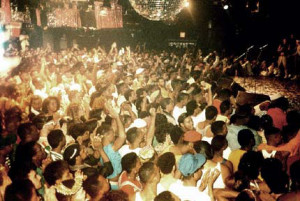
To get you in the mood for the weekend, every Friday we’ll be celebrating ‘FRIDAY NIGHT FEVER’, featuring an old New York nightlife haunt, from the dance halls of 19th Century Bowery, to the massive warehouse spaces of the mid-90s. Past entries can be found here .
There are few nightclubs in the modern history of New York City that have as much good will attached to them than the Paradise Garage. While other clubs burn out or die, the “Garage” as it came to be referred is spoken about in reverent terms, almost as if it’s still open. The reason is simple — for better or for worse, it’s the birth of the modern nightclub.
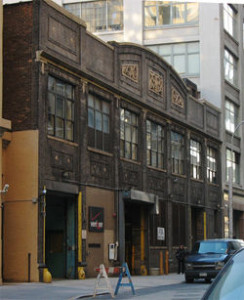 Born from a parking garage on 84 King Street, south of SoHo, in an area still festooned with warehouses, the Garage formed out of the early attempts of a disco called the Chameleon. Owner Michael Brody spent months retooling it as a vast heavenly warehouse and would often host ‘construction parties’ to generate buzz. By the opening on February 17, 1978, he was ready to greet the city.
Born from a parking garage on 84 King Street, south of SoHo, in an area still festooned with warehouses, the Garage formed out of the early attempts of a disco called the Chameleon. Owner Michael Brody spent months retooling it as a vast heavenly warehouse and would often host ‘construction parties’ to generate buzz. By the opening on February 17, 1978, he was ready to greet the city.
Unfortunately, so was a devastating blizzard. The sound system was in boxes stranded at the airport while hundreds of partiers were outside, stranded in the snow. It could have been over before it began.
If not for the master of ceremonies — Larry Levan. The Garage was front and center about the music, and Levan, who has since become the patron saint of deejays, was the one who put it there. His music style would smoothly transport disco into the ’80s, and in the process helping popularize a new style of dance music called house — electronic infusions into soul, funk and disco. In fact, ‘garage music’ is a specific type of house, giving what would become house a raw, ‘big room’ urban quality. And named, of course, after the Paradise Garage.
The seeds of the Paradise Garage philosophy were planted in the mid 70s with roving parties under the banner called The Loft. Before then, New York nightclubs still had a primary focus, held over from the ’50s and ’60s, of being social gathering places, where people — often famous people — met other people, lubricated by booze. The music itself was often wallpaper.
The Garage essentially refocused the nightclub experience from meeting places to houses of music worship. The club served no liquor and, mostly notably, was a dancefloor for regular people in an era where locales were eagerly trying to attract celebrities and press. It was also ‘members only’, which served not to create an elitist exclusivity, but rather to ensure that every there was ‘all about the music’.
It’s no surprise that the Garage had a superb sound system, reputedly the best in New York, created by Levan and Richard Long to make the new sounds of house literally rumble underfoot, not to mention those murals on the walls by Keith Haring. Not to be outdone, the dazzling strobe and effects were courtesy of almost 730 lighting features, grown from just a dozen or so from the first days of the club.
According to A Garage Tribute, a heartfelt recollection site : “thunderous audio would burst through your heart like a bolt of lighting. . . the warm base vibration would lift you from the floor suspending you weightless, your heart would race and senses would tingle.” Its design has literally influenced every major dance club in the world, from New York to Europe and beyond.
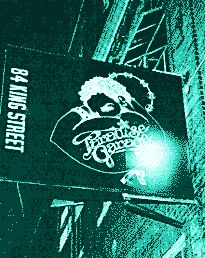 Notably, the Garage clientele was black and Latino, mostly gay, in stark contrast to uptown’s whiter, straighter crowd. But as the club’s reputation grew, so did the makeup of the revelers. That was reflected in the talent that would occasionally arrive on stage — Madonna, Loleatta Holloway, New Order, Phyllis Hyman and Taana Gardner (whose song ‘Heartbeat’ might be considered the ultimate Paradise Garage tune).
Notably, the Garage clientele was black and Latino, mostly gay, in stark contrast to uptown’s whiter, straighter crowd. But as the club’s reputation grew, so did the makeup of the revelers. That was reflected in the talent that would occasionally arrive on stage — Madonna, Loleatta Holloway, New Order, Phyllis Hyman and Taana Gardner (whose song ‘Heartbeat’ might be considered the ultimate Paradise Garage tune).
Levan would lord over the proceedings in a deejay tower high above, a sort of musical wizard. According to Disco Disco, Steve Rubell of Studio 54 even attempted to lure Levan away from Garage. Larry’s response: “They’re not ready for me yet.”
A familiar enemy ended the Garage September 1987 — high rent and gentrification. Levan himself died in 1992, having literally partied himself out, according to In Da Mix Worldwide. A beautiful look into the Garage years can be found on CD — “Journey into Paradise: The Larry Levan Story“, a highly infectious time-capsule of some of the Garage’s greatest hits.

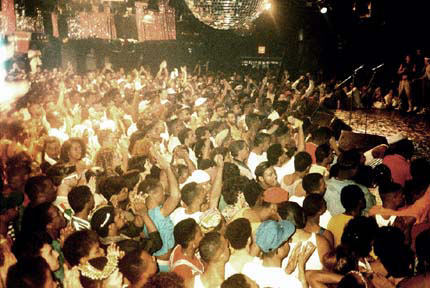
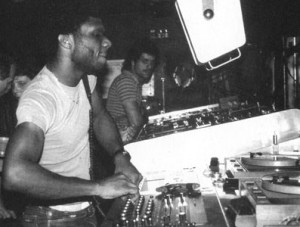
3 replies on “FRIDAY NIGHT FEVER: Paradise Garage”
Hey Guys,
Fabulous podcast! I would love to hear one on the East Village. I took a walking tour of the East Village a few years back and it was a lot of fun. Can you suggest any other walking tours in the city?
Also, I would love to see more on famous NY personalities such as Andy Warhol, Fiorello LaGuardia, Teddy Roosevelt, Lou Reed, etc.
Ricky D
Excellent article. Thanks!
Website design India, web design india
web design New york city
I will be available in online for link exchange from 9am to 7pm (IST)
chat id : fastlinkmaster@gmail.com, Skype: ananthakumar007